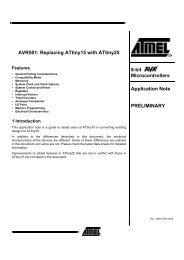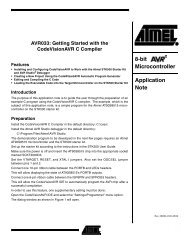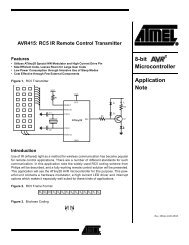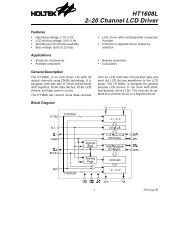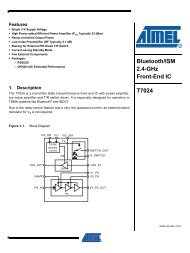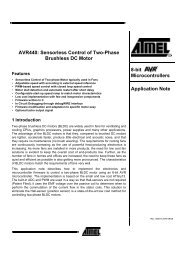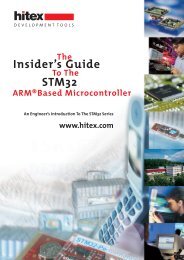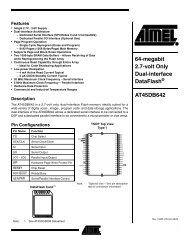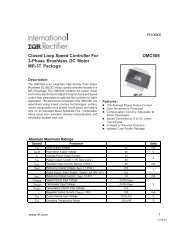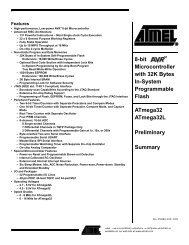Preliminary C8051F120/1/2/3 C8051F124/5/6/7 - KEMT FEI TUKE
Preliminary C8051F120/1/2/3 C8051F124/5/6/7 - KEMT FEI TUKE
Preliminary C8051F120/1/2/3 C8051F124/5/6/7 - KEMT FEI TUKE
Create successful ePaper yourself
Turn your PDF publications into a flip-book with our unique Google optimized e-Paper software.
<strong>Preliminary</strong><br />
<strong>C8051F120</strong>/1/2/3<br />
<strong>C8051F124</strong>/5/6/7<br />
15. FLASH MEMORY<br />
The C8051F12x family includes 128k + 256 bytes of on-chip, reprogrammable FLASH memory for program code<br />
and non-volatile data storage. The FLASH memory can be programmed in-system through the JTAG interface, or by<br />
software using the MOVX write instructions. Once cleared to logic 0, a FLASH bit must be erased to set it back to<br />
logic 1. Bytes should be erased (set to 0xFF) before being reprogrammed. FLASH write and erase operations are<br />
automatically timed by hardware for proper execution. During a FLASH erase or write, the FLBUSY bit in the<br />
FLSTAT register is set to ‘1’ (see Figure 16.8). During this time, instructions that are located in the prefetch buffer or<br />
the branch target cache can be executed, but the processor will stall until the erase or write is completed if instruction<br />
data must be fetched from FLASH memory. Interrupts that have been pre-loaded into the branch target cache can<br />
also be serviced at this time, if the current code is also executing from the prefetch engine or cache memory. Any<br />
interrupts that are not pre-loaded into cache, or that occur while the core is halted, will be held in a pending state during<br />
the FLASH write/erase operation, and serviced in priority order once the FLASH operation has completed. Refer<br />
to Table 15.1 for the electrical characteristics of the FLASH memory.<br />
15.1. Programming The Flash Memory<br />
The simplest means of programming the FLASH memory is through the JTAG interface using programming tools<br />
provided by Cygnal or a third party vendor. This is the only means for programming a non-initialized device. For<br />
details on the JTAG commands to program FLASH memory, see Section “25. JTAG (IEEE 1149.1)” on page 305.<br />
The FLASH memory can be programmed from software using the MOVX write instruction with the address and data<br />
byte to be programmed provided as normal operands. Before writing to FLASH memory using MOVX, FLASH write<br />
operations must be enabled by setting the PSWE Program Store Write Enable bit (PSCTL.0) to logic 1. This directs<br />
the MOVX writes to FLASH memory instead of to XRAM, which is the default target. The PSWE bit remains set<br />
until cleared by software. To avoid errant FLASH writes, it is recommended that interrupts be disabled while the<br />
PSWE bit is logic 1.<br />
FLASH memory is read using the MOVC instruction. MOVX reads are always directed to XRAM, regardless of the<br />
state of PSWE.<br />
The COBANK bits in the PSBANK register (Figure 12.3) determine which of the upper three FLASH banks are<br />
mapped to the address range 0x08000 to 0x0FFFF for FLASH writes, reads and erases.<br />
NOTE: To ensure the integrity of FLASH memory contents, it is strongly recommended that the on-chip VDD<br />
monitor be enabled by connecting the VDD monitor enable pin (MONEN) to VDD in any system that writes<br />
and/or erases FLASH memory from software. See “RESET SOURCES” on page 155 for more information.<br />
A write to FLASH memory can clear bits but cannot set them; only an erase operation can set bits in FLASH. Abyte<br />
location to be programmed must be erased before a new value can be written.<br />
15.1.1. Non-volatile Data Storage<br />
The FLASH memory can be used for non-volatile data storage as well as program code. This allows data such as calibration<br />
coefficients to be calculated and stored at run time. Data is written and erased using the MOVX write instruction<br />
(as described in Section 15.1.2 and Section 15.1.3) and read using the MOVC instruction. The COBANK bits in<br />
register PSBANK (Figure 12.3) control which portion of the FLASH memory is targeted by writes and erases of<br />
addresses above 0x07FFF.<br />
Two additional 128-byte sectors (256 bytes total) of FLASH memory are included for non-volatile data storage. The<br />
smaller sector size makes them particularly well suited as general purpose, non-volatile scratchpad memory. Even<br />
though FLASH memory can be written a single byte at a time, an entire sector must be erased first. In order to change<br />
a single byte of a multi-byte data set, the data must be moved to temporary storage. The 128-byte sector-size facili-<br />
© 2002 Cygnal Integrated Products, Inc. DS008-0.8-AUG02 Page 173



